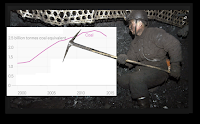In 2014 coal use declined in China and this trend continues into 2015. China cut its coal use by 2.9 percent in 2014. This was the first time coal use diminished in country this century. In the first four months of 2015, coal use fell another 8 percent compared to the previous year. year on year. Reductions in coal use are having a commensurate impact on emissions. According to a recent analysis by Greenpeace, China's CO2 emissions have declined by almost 5 percent, year over year, in the first four months of 2015.
This suggests that China may be able to achieve its peak coal use earlier than expected. China's overall coal use will peak somewhere around 2020 and it is hoped that there will be a reduction of at least 500 million tonnes between 2020-2030
Chinese coal use is a crucial issue as far as global carbon emissions are concerned. Almost 80 percent of China's energy-related carbon emissions are attributable to coal. Electricity makes up about half of China's coal consumption and industry accounts for the other half.
However, the average energy use is a fraction of what it is in Europe or the US. The average household in China uses just 1,500 kilowatt-hours of electricity per year, the average household in Germany uses 5,830 kWh per year while the average home in the US uses 12,000 kWh per year.
In China there is a smog crisis and growing concern from the government about a new breed of environmental activist that want to combat the problem. The government has passed air pollution laws in Beijing to reign in rampant smog pollution. These efforts also include closing all the coal plants around Beijing by 2017 and many of its smaller coal mines.
- Blogger Comment
- Facebook Comment
Subscribe to:
Post Comments
(
Atom
)

0 comments:
Post a Comment